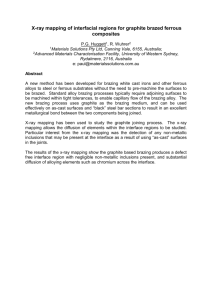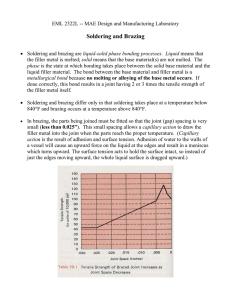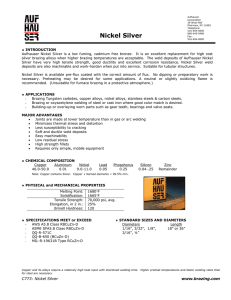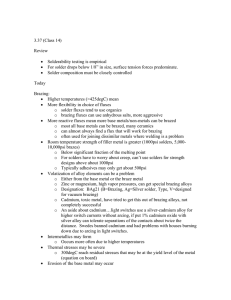1. Introduction Corrosion-resistant chromium (11.5÷19%Cr) and
advertisement
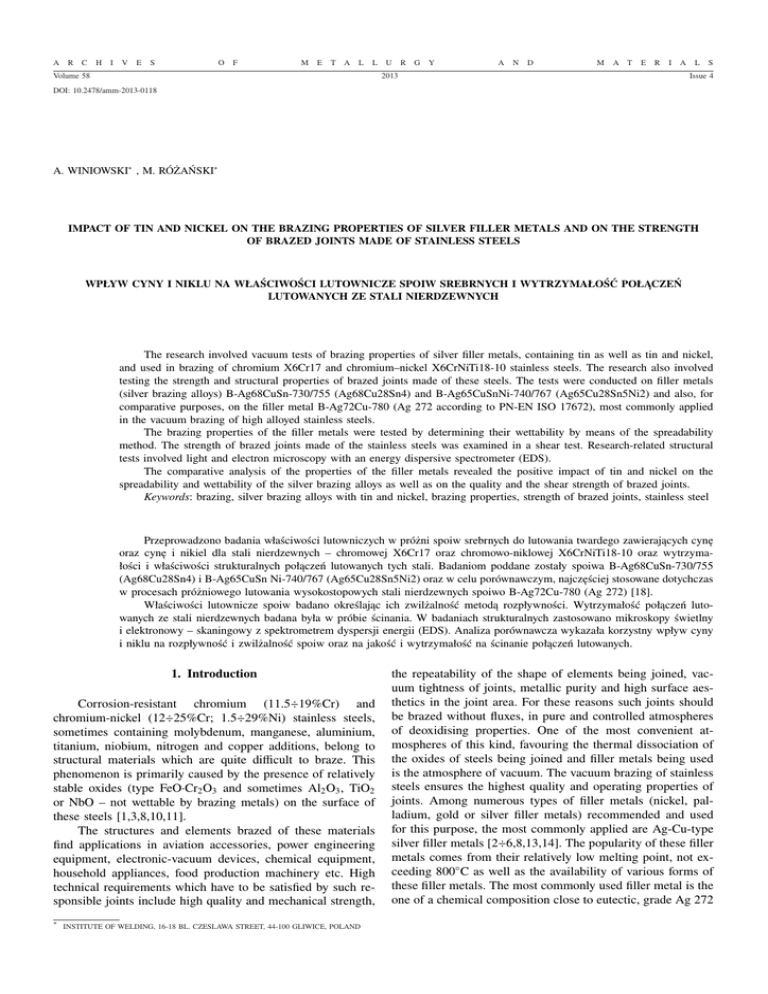
A R C H I V E S O F M E T A L L Volume 58 U R G Y A N D M A T E R I A 2013 L S Issue 4 DOI: 10.2478/amm-2013-0118 A. WINIOWSKI∗ , M. RÓŻAŃSKI∗ IMPACT OF TIN AND NICKEL ON THE BRAZING PROPERTIES OF SILVER FILLER METALS AND ON THE STRENGTH OF BRAZED JOINTS MADE OF STAINLESS STEELS WPŁYW CYNY I NIKLU NA WŁAŚCIWOŚCI LUTOWNICZE SPOIW SREBRNYCH I WYTRZYMAŁOŚĆ POŁĄCZEŃ LUTOWANYCH ZE STALI NIERDZEWNYCH The research involved vacuum tests of brazing properties of silver filler metals, containing tin as well as tin and nickel, and used in brazing of chromium X6Cr17 and chromium–nickel X6CrNiTi18-10 stainless steels. The research also involved testing the strength and structural properties of brazed joints made of these steels. The tests were conducted on filler metals (silver brazing alloys) B-Ag68CuSn-730/755 (Ag68Cu28Sn4) and B-Ag65CuSnNi-740/767 (Ag65Cu28Sn5Ni2) and also, for comparative purposes, on the filler metal B-Ag72Cu-780 (Ag 272 according to PN-EN ISO 17672), most commonly applied in the vacuum brazing of high alloyed stainless steels. The brazing properties of the filler metals were tested by determining their wettability by means of the spreadability method. The strength of brazed joints made of the stainless steels was examined in a shear test. Research-related structural tests involved light and electron microscopy with an energy dispersive spectrometer (EDS). The comparative analysis of the properties of the filler metals revealed the positive impact of tin and nickel on the spreadability and wettability of the silver brazing alloys as well as on the quality and the shear strength of brazed joints. Keywords: brazing, silver brazing alloys with tin and nickel, brazing properties, strength of brazed joints, stainless steel Przeprowadzono badania właściwości lutowniczych w próżni spoiw srebrnych do lutowania twardego zawierających cynę oraz cynę i nikiel dla stali nierdzewnych – chromowej X6Cr17 oraz chromowo-niklowej X6CrNiTi18-10 oraz wytrzymałości i właściwości strukturalnych połączeń lutowanych tych stali. Badaniom poddane zostały spoiwa B-Ag68CuSn-730/755 (Ag68Cu28Sn4) i B-Ag65CuSn Ni-740/767 (Ag65Cu28Sn5Ni2) oraz w celu porównawczym, najczęściej stosowane dotychczas w procesach próżniowego lutowania wysokostopowych stali nierdzewnych spoiwo B-Ag72Cu-780 (Ag 272) [18]. Właściwości lutownicze spoiw badano określając ich zwilżalność metodą rozpływności. Wytrzymałość połączeń lutowanych ze stali nierdzewnych badana była w próbie ścinania. W badaniach strukturalnych zastosowano mikroskopy świetlny i elektronowy – skaningowy z spektrometrem dyspersji energii (EDS). Analiza porównawcza wykazała korzystny wpływ cyny i niklu na rozpływność i zwilżalność spoiw oraz na jakość i wytrzymałość na ścinanie połączeń lutowanych. 1. Introduction Corrosion-resistant chromium (11.5÷19%Cr) and chromium-nickel (12÷25%Cr; 1.5÷29%Ni) stainless steels, sometimes containing molybdenum, manganese, aluminium, titanium, niobium, nitrogen and copper additions, belong to structural materials which are quite difficult to braze. This phenomenon is primarily caused by the presence of relatively stable oxides (type FeO·Cr2 O3 and sometimes Al2 O3 , TiO2 or NbO – not wettable by brazing metals) on the surface of these steels [1,3,8,10,11]. The structures and elements brazed of these materials find applications in aviation accessories, power engineering equipment, electronic-vacuum devices, chemical equipment, household appliances, food production machinery etc. High technical requirements which have to be satisfied by such responsible joints include high quality and mechanical strength, ∗ INSTITUTE OF WELDING, 16-18 BL. CZESLAWA STREET, 44-100 GLIWICE, POLAND the repeatability of the shape of elements being joined, vacuum tightness of joints, metallic purity and high surface aesthetics in the joint area. For these reasons such joints should be brazed without fluxes, in pure and controlled atmospheres of deoxidising properties. One of the most convenient atmospheres of this kind, favouring the thermal dissociation of the oxides of steels being joined and filler metals being used is the atmosphere of vacuum. The vacuum brazing of stainless steels ensures the highest quality and operating properties of joints. Among numerous types of filler metals (nickel, palladium, gold or silver filler metals) recommended and used for this purpose, the most commonly applied are Ag-Cu-type silver filler metals [2÷6,8,13,14]. The popularity of these filler metals comes from their relatively low melting point, not exceeding 800◦ C as well as the availability of various forms of these filler metals. The most commonly used filler metal is the one of a chemical composition close to eutectic, grade Ag 272 1008 (B-Ag72Cu-780) [18]. As it was already mentioned, due to the high stability of the oxides present on the surface of stainless steels and the weak chemical effect of iron and silver, this filler metal only slightly wets chromium and chromium-nickel stainless steels in vacuum. This fact entails the necessity of using higher brazing temperatures (above 850÷900◦ C, even approximately 1000◦ C) and longer hold times [10,11,13,14]. In order to increase the wetting properties of silver filler metals for iron alloys, it is necessary to add to them such chemical elements as tin, nickel, manganese, lithium, palladium, titanium etc.[2,3,5,12,14]. This study presents tests of the brazing properties of Ag-Cu type filler metals with an addition of Sn as well as Sn and Ni during the vacuum brazing of joints made of chromium and chromium-nickel stainless steels. The work also describes the mechanical and structural properties of these joints [17]. It should be emphasized that available specialist publications, except for general technical information, do not contain detailed, extensive and unified information about the brazing properties of these filler metals, neither do they contain information related to the mechanical and structural properties of the joints made of stainless steels using these filler metals. 2. Parent and filler metals used in tests Parent metals used in the tests were in the form of 1.5mm-thick sheets made of stainless steels corresponding to steels most commonly used in production processes i.e. chromium stainless steel (of ferritic structure) grade X6Cr17 and chromium-nickel stainless steel (of austenitic structure) grade X6CrNiTi18-10 according to PN-EN 10088-2. The chemical compositions of these steels, according to their conformity certificates, are presented in Table 1. TABLE 1 Chemical composition of steels used in tests Grade Chemical composition, % (weight) C Si Mn Cr 16.0÷ X6Cr17 0.08 1.00 1.00 18.0 17.0÷ X6CrNiTi18-10 0.08 1.00 2.00 19.0 Ni – P S 0.04 0.015 Ti on the surface of a material being joined and penetrates, in a capillary the brazing gap of the joint. These phenomena also condition the further proper course of diffusing and dissolving processes during the formation of a brazed joint. For this reason, the assessment of the wetting of materials being brazed with a filler metal in specified technological conditions constitutes the basis for testing the brazing properties of filler metals or the assessment of the brazeability of parent metals [2÷5,7, 9,15]. The methods of such tests involving braze metals are not the subject of any European (EN) and international (ISO) standards at the moment. One may come across these methods only in handbooks and research publications [2÷7,9,13÷15]. The most common method of testing the wetting properties of braze metals is the test of their spreadability on a material being joined in specified technological conditions. This method takes into account the favourable technological conditions of brazing, the preparation and condition (roughness) of the surface of a material being joined etc.[6,16]. The spreadability tests of the filler metals B-Ag68CuSn-730/755 and B-Ag65CuSnNi-740/767 were carried out on stainless steel samples (30×30×1.5 mm). Prior to testing the samples were subjected to grinding with abrasive paper in order to homogenise of their surface. Additionally, directly before testing, the samples were degreased with acetone. The steel samples with 1.5g filler metal applied on their surface were placed in the vacuum chamber of a furnace S16 manufactured by TORVAC. During the spreadability tests the temperature of the samples was controlled by means of a thermocouple type Pt-PtRh13 (equipment of the vacuum furnace), placed under one of the samples. All the samples were heated in vacuum in the range 10−4 ÷ 10−5 mbar. The tests were carried out at 880◦ C, 920◦ C, 960◦ C and 1000◦ C. The hold time at the test temperature was 10 minutes in each case. The elements were cooled in vacuum to 200◦ C, and next, in argon atmosphere of forced circulation. The adopted spreadability measure was the planimetric size of the area on which the braze metal was spread. The test results are presented in Fig. 1 and Fig. 2. – 9.0÷ 5C÷ 0.045 0.015 12.0 0.7 Filler metals used in the tests were the following silver brazing alloys in the form of 0.1mm-thick foils: – B-Ag68CuSn-730/755 (Ag68Cu28Sn4); – B-Ag65CuSnNi-740/767 (Ag65Cu28Sn5Ni2). For comparative purposes, the tests also involved the use of the filler metal B-Ag72Cu-780 (Ag 272) [18], most commonly applied in the vacuum brazing of high alloyed stainless steels. 3. Wettability tests Fig. 1. Spreading area of fillers brazing metals at the chromium – nickel stainless steel grade X6CrNiTi18-10 in different temperatures The basic and indispensable condition for obtaining a brazed joint is wetting a material to be joined with a filler metal during brazing. As a result, the brazing metal spreads The tests revealed that the highest spreadability on the surface of stainless steels characterised the silver brazing alloy with nickel and tin, grade B-Ag65CuSnNi – 740/767. For the 1009 austenitic steel (X6CrNiTi18-10, Fig. 1) the spreadability (the area on which the brazing metal was spread – 56÷58 mm2 ) was relatively high already at the lowest test temperature i.e. 880◦ C and 920◦ C. At 960÷1000◦ C the spreadability was slightly higher (60÷65 mm2 ). In turn, the brazing alloy with tin grade B-Ag68CuSn-730/755 revealed similar spreadability (55÷58 mm2 ) only at 1000◦ C. The comparatively applied Ag-Cu-type silver brazing alloy without alloy additions, of eutectic composition (B-Ag72Cu – 780) was characterised by lower spreadability (20÷40 mm2 ) at all of the test temperatures. the joints made with the brazing silver B-Ag68CuSn (for the chromium steel – 170 MPa and for the chromium-nickel steel – 112 MPa) and the lowest strength characterised the joints made with the brazing silver B-Ag72Cu (for the chromium steel – 160 MPa and for the chromium-nickel steel – 107 MPa). Fig. 3. Shear strength of stainless steels (X6CrNiTi18-10 and X6Cr17) joints brazed with silver brazing alloys (B-Ag72Cu-780, B-Ag68CuSn-730/755 and B-Ag65CuSnNi-740/767) at temperature 1000◦ C at a hold time of 15 min. Fig. 2. Spreading area of fillers brazing metals at the chromium stainless steel grade X6Cr17 in different temperatures In the case of the chromium ferritic steel (X6Cr17, Fig. 2) the highest spreadability at temperatures 880÷920◦ C and 960÷1000◦ C also characterised the silver brazing alloy with tin and nickel (B-Ag65CuSnNi – 740/767) – 45÷50 mm2 and 105÷130 mm2 respectively. The filler metal with tin (B-AgCuSn – 730/755) was, in turn, characterised by lower spreadability, similarly like the brazing alloy without alloy additions, of the eutectic composition (B-Ag72Cu – 780). At 880÷920◦ C the spreadability, expressed by the area on which the brazing metal was spread, was approximately 13÷29 mm2 and at 960÷1000◦ C was contained in the 40÷55 mm2 range. 4. Shear tests of brazed joints The mechanical properties of the stainless steel joints brazed with the tested silver brazing alloys were carried out using overlap samples (one-sided overlap, 30 mm in width), made of sheets of dimensions: 10 mm×100 mm×2 mm. The samples for shear tests were vacuum-brazed at 1000◦ C at a hold time of 15 min. The strength tests were carried out with an Instron-made testing machine model 4210, using three samples of each steel (austenitic – X6CrNiTi18-10 and ferritic – X6Cr17), for each of the brazing alloys: B-Ag72Cu-780, B-Ag68CuSn-730/755 and B-Ag65CuSnNi-740/767. The test results are presented in Fig. 3. The shear tests of the brazed overlap joints of both grades of stainless steels revealed higher results for the joints made of the chromium steel. The highest strength characterised the joints made with the brazing silver B-Ag65CuSnNi (for the chromium steel – 195 MPa and for the chromium-nickel steel – 141 MPa), slightly lower strength was revealed in the case of 5. Structural tests of brazed joints The assessments of the quality of the joints made of the austenitic steel – X6CrNiTi18-10 and ferritic steel – X6Cr17 brazed with the silver brazing alloys grades B-Ag72Cu-780, B-Ag68CuSn-730/755 and B-Ag65CuSnNi-740/767 were carried out in metallographic tests involving the use of a Leica-made light microscope MeF4A. The test-related observation covered the whole area of the brazed joints for each of the brazing silvers used in the tests. The joints were characterised by proper quality along their whole length. Fig. 4 presents the structures of the joints brazed at 1000◦ C at a hold time of 10 min. Further structural tests were carried out with a scanning electron microscope (SEM) collaborating with an energy dispersive X-ray spectrometer (EDS). The samples selected for the tests were those made with the most favourable brazing silver grade i.e. B-Ag65CuSnNi-740/767. The tests were conducted with a scanning electron microscope SEM VP S-3600N HITACHI with an energy dispersive X-ray spectrometer manufactured by THERMO NORAN, equipped with a System Six analyser. The results of tests are presented in Fig. 5 and 6. 1010 Fig. 4. Microstructures of the joints of stainless steels grades X6Cr17 (subscript 1) and X6CrNiTi18-10 (subscript 2) brazed with silver brazing alloys grades B-Ag72Cu-780 (a), B-Ag68CuSn-730/755 (b) and B-Ag65CuSnNi-740/767 (c) at temperature 1000◦ C at a hold time of 10 min (etch. FeCl3 ) Fig. 6. Microstructure of the joint of steel grade X6Cr17 brazed with the filler metal B-Ag65CuSnNi-740/767 at temperature 1000◦ C/hold time 10 min, (SEM) and results of energy dispersive spectrometry (EDS) 6. Conclusions Fig. 5. Microstructure of the joint of steel grade X6CrNiTi18-10 brazed with the filler metal B-Ag65CuSnNi-740/767 at temperature 1000◦ C/hold time 10 min, (SEM) and results of energy dispersive spectrometry (EDS) The tests revealed that the obtained brazes were composed of the mixture of solid solutions based on copper and silver. The solid solutions in brazing joints of steel grade X6CrNiTi18-10 contain in % at.: 87,48 Cu, 5,06 Ag, 1,36 Fe, 1,28 Ni, 4,82 Sn and 85,92 Ag, 10,40 Cu, 3,67 Sn (Fig. 1). Whereas in in brazing joints of steel grade X6Cr17 there are such solutions, in % at.: 74,46 Cu, 22,94 Ag, 2,60 Fe, 4,27 Sn; 82,29 Cu, 1039 Ag, 3,15 Fe; 58,41 Cu, 13,67 Ag, 2,35 Fe, 1,23 Ni and 85,53 Ag, 8,95 Cu, 2,29 Fe, 3,23 Sn (Fig. 6). The alloy additions such as tin as well as tin and nickel were present in these solutions. Tin was present in both solid solutions, whereas nickel was present in the copper-based solid solution. These chemical elements strengthen the braze. 1. The spreadability tests conducted on chromium-nickel steel (X6CrNiTi 18-10) and chromium steel (X6Cr17) revealed that the most favourable brazing properties characterised the silver brazing alloy with tin and nickel (B-Ag65CuSnNi-740/767). The tests involved the following brazing silver grades: B-Ag72Cu-780, B-Ag68CuSn-730/755 and B-Ag72Cu-780. 2. The filler metal B-Ag65CuSnNi-740/767 also ensures the high quality of joints and the highest shear strength (among all the tested silver brazing alloys), for the steel steel X6CrNiTi 18-10 – 142 MPa and for the steel X6Cr17 – 195 MPa. 3. The structures of the joints made using silver brazing alloys with tin (B-Ag68CuSn-730/755) as well as with tin and nickel (B-Ag68CuSn-730/755) were composed of the solid solutions based on copper and silver, strengthened by tin as well as tin and nickel additions. 3. The results of the tests of the brazing properties of the silver brazing alloys and the joints brazed with these alloys revealed that the most favourable filler metal for vacuum brazing of stainless steels at 960÷1000◦ C was the brazing alloy grade B-Ag65CuSnNi-740/767. REFERENCES [1] L.A. D o b r z a ń s k i, Fundamentals of material science. WNT, Warszawa (2002) (in Polish). [2] M. S c h w a r z, Brazing. Ed. 2, ASM International, Materials Park, Ohio (2003). [3] Joint publication, Brazing Handbook, AWS, Miami (2007). [4] W. M ü l l e r, J.U. M ü l l e r, Löttechnik. DVS, Düseldorf (1995) (in German). [5] Joint publication, Spravočnik po pajkie. Mašinostrojenie, Moskva (2003) (in Russian). [6] Joint publication, Poradnik Inżyniera. Spawalnictwo. T. 1 i 2 WNT, Warszawa (2004/2005) ( in Polish). 1011 [7] Z. M i r s k i, Spajanie węglików spiekanych ze stalą. O.W P.W. Wrocław (2011) (in Polish). [8] W.F. H o r u n o v, Osnovy pajki tonkostiennyh konstrukcij iz vysokolegirowannych stalej. Naukovaja Dumka, Kijev (2008) (in Russian). [9] J. N o w a c k i, M. C h u d z i ń s k i, P. Z m i t r o w i c z, Lutowanie w budowie maszyn. WNT, Warszawa (2007) (in Polish). [10] Y. A r a t a, A. O h m o r i, H.H. C a l, Studies on vacuum brazing (report II) – Removal of oxide film from stainless steel surface and brazing alloy spreading mechanism. Transaction of JWRI 1, 12-17 (1983). [11] O. K o z l o v a, R. V o j t o w y c h, N. D e v i s e m e s, N. E u s t a t h o p u l o s, Wetting and brazing stainless steels by copper – silver eutectic. Materials Science and Enginering. A 405, 35-41 (2008). [12] B. K e m p f, New brazing solders for the joining of chrome – nickel steels. Welding and Cutting 53, 1, 21-25 (2001). Received: 10 April 2012. [13] A. W i n i o w s k i, Mechanical and structural properties of joint of stainless steel and titanium brazed with silver filler metals containing tin. Archives of Metallurgy and Materials 55, 4, 991-1000 (2010). [14] W. G ą s i o r, A. W i n i o w s k i, Properties of silver brazing alloys containing lithium. Archives of Metallurgy and Materials 57, 4, 1087-1093 (2012). [15] Z. M i r s k i, T. P i w o w a r c z y k, Wettability of hardmetal surfaces prepared for brazing with various methods. Archives of Civil and Mechanical Engineering 11, 2, 407-416 (2011). [16] A. W i n i o w s k i, Lutowność w lutowaniu twardym – definicje i przykłady jej badania. Przegląd Spawalnictwa 9, 58-62 (2010) (in Polish). [17] A. W i n i o w s k i, M. R ó ż a ń s k i, The Final Report of Statutory R&D Activity. Gh-16, Institute of Welding, Gliwice (2010) (in Polish). [18] PN-EN ISO 17672:2010: Lutowanie twarde – Spoiwa.
